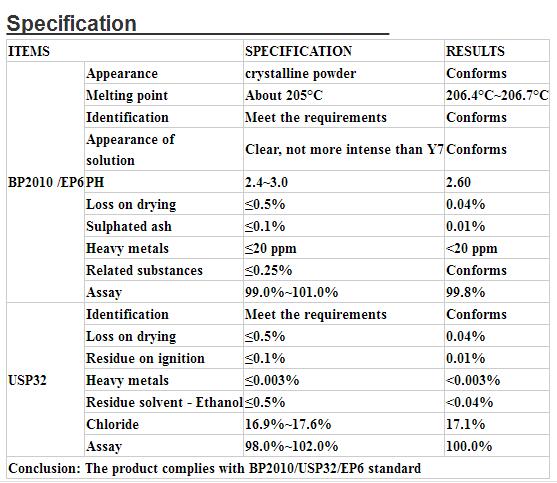High quality pharmaceutical Grade Ampicillin//69-53-4, GMP
English name Ampicillin
CAS RN 69-53-4
Molecular formula: C16H19N3O4S
Molecular weight 349.4
Traits: This product is white crystalline powder; taste slightly bitter.
Ampicillin is a betalactam antibiotic that has been used extensively to treat bacterial infections since 1961. Until the introduction of ampicillin by the British companyBeecham, penicillin therapies had only been effective against Gram-positive organisms such as staphylococci and streptococci. Ampicillin (originally branded as 'Penbritin') also demonstrated activity against Gram-negative organisms such as H. influenzae, coliforms and Proteus spp.
Ampicillin was the first of a number of so-called broad spectrum penicillins subsequently introduced by Beecham.
Ampicillin is part of the aminopenicillin family and is roughly equivalent to its successor, amoxicillin in terms of spectrum and level of activity.[1] It can sometimes result in reactions that range in severity from a rash (in the case of patients that may unwittingly have mononucleosis) to potentially lethal allergic reactions such as anaphylaxis. However, as with other penicillin drugs, it is relatively non-toxic and adverse effects of a serious nature are encountered only rarely.
Analysis Sheet

Function
Ampicillin is in the penicillin group of beta-lactam antibiotics and is part of the aminopenicillin family. It is roughly equivalent to amoxicillin in terms of activity.
Ampicillin is able to penetrate Gram-positive and some Gram-negative bacteria. It differs from penicillin G, or benzylpenicillin, only by the presence of an amino group. That amino group helps the drug penetrate the outer membrane of Gram-negative bacteria.
Ampicillin acts as an irreversible inhibitor of the enzyme transpeptidase, which is needed by bacteria to make theircell walls.It inhibits the third and final stage of bacterial cell wall synthesis in binary fission, which ultimately leads to cell lysis; therefore ampicillin is usually bacteriolytic.
Application
It is active against many Gram-positive and Gram-negative bacteria.Ampicillin was the first 'broad spectrum' penicillin with activity against Gram-(+) bacteria including Streptococcus pneumoniae, Streptococcus pyogenes, some isolates of Staphylococcus aureus (but not penicillin-resistant or methicillin-resistant strains), and some Enterococci. Activity against Gram-(−) bacteria includes Neisseria meningitidis, someHaemophilus influenzae, and some Enterobacteriaceae. Its spectrum of activity is enhanced by co-administration ofsulbactam, a drug that inhibits beta lactamase, an enzyme produced by bacteria to inactivate ampicillin and related antibiotics.
It is used for the treatment of infections known to be or highly likely to be caused by these bacteria. These include common respiratory infections including sinusitis, bronchitis, and pharyngitis, as well as otitis media. In combination with vancomycin (which provides coverage of ampicillin-resistant pneumococci), it is effective for the treatment of bacterial meningitis. It is also used for gastrointestinal infections caused by consuming contaminated water or food, such as Salmonella, Shigella, and Listeriosis.
Ampicillin is a first-line agent for the treatment of infections caused by Enterococci. The bacteria are an important cause of healthcare-associated infections such as endocarditis, meningitis, and catheter-associated urinary tract infections that are typically resistant to other antibiotics.
